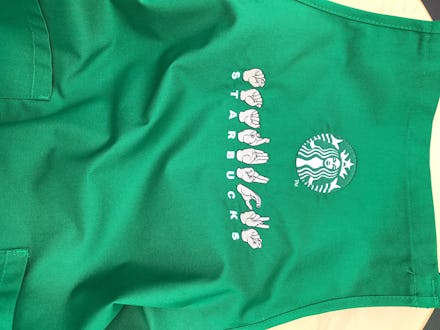Starbucks will open its first US store where every employee knows American Sign Language

On Thursday, Starbucks announced it will open its first Signing Store in America in October, dedicated to hiring and serving the deaf and hard of hearing community.
The store will be located in Washington, D.C., near Gallaudet University — a school for the deaf and hard of hearing — and employ 20 to 25 people proficient in American Sign Language, including those who are deaf and hard of hearing and those who are not.
Design elements were created with people who have hearing loss in mind, including low-glare surfaces, which help to remove visual distractions when communicating through ASL, and open spaces that allow for ASL signs to be conveyed across a room. Baristas will also wear embroidered ASL aprons and deaf employees will have pins that denote their ability to sign. Starbucks has another Signing Store in Kuala Lumpur, Malaysia, which opened in 2016.
While the company has yet to announce how non-signing patrons will communicate with employees, Adam Novsam, who is part of Starbucks’ Deaf Leadership team, said through an ASL interpreter over the phone that the company has embraced accessible technology before and will likely do so in its proposed store. Novsam said that other stores with employees who are deaf or hard of hearing have incorporated voice to technology software and iPads that allow individuals to communicate through sign language interpreters.
However, with the recent arrest of two African-American men at a Philadelphia store, skepticism is apparent. “My gut impression is that it’s a great idea,” Laurie Hanin, the Executive Director at the Center for Hearing and Communication, said over the phone. “And everyone could be really cynical and say that it’s a response to not being open to diverse communities — but everything starts somewhere.”
We spoke to organizations that focus on the needs of the deaf and hard of hearing about their thoughts on the proposed store. While these changes are a step toward inclusiveness for the deaf and hard of hearing, there are still several ways in which Starbucks can modify the shop to best incorporate the community at large.
Technology should embrace the entirety of the deaf and hard of hearing community
“There tends to be a misconception that deaf people sign, but most people who are hard of hearing don’t sign,” Hanin said. “There are a lot of deaf people who are oral and speak and choose to communicate with hearing aids or cochlear implants. They can go up to any counter, even in a noisy environment, talk to a person they’re giving their order to and hear their name announced.”
Hanin said for the store to be inclusive of the entire community, Starbucks should embrace technologies that benefit those who do not sign, including the use of visual display systems like LED screens and looping service counters, a system that allows those with hearing aids to cut out background noise that enters hearing aids.
“If all they’re doing is sign language, they’re leaving out part of the deaf community that always gets left out,” Hanin said. “But if they added in [these methods], then they are accessible to the entire deaf and hard of hearing community.”
Open spaces should be carefully planned
Open spaces for communication are useful, Jonathan Dollhopf, a Deaf Systems Advocate at the Regional Center for Independent Living, said through an ASL interpreter over the phone. Columns and walls can obstruct hearing and an open layout would allow for those who are deaf or hard of hearing to communicate better by way of ASL, he added.
However, open layouts are a double-edged sword, Gayla H. Guignard, chief strategy officer at the Alexander Graham Bell Association for the Deaf and Hard of Hearing, said in a phone interview. “Acoustically, an open layout does impact hearing. If you have a wall in a restaurant, often times a person who uses a hearing aid will want to sit up against that wall because the acoustics are better,” she said, which could be an obstruction to those who don’t rely on the visual cues of ASL. “But for someone who uses ASL, taking the walls down essentially allows them to see language across rooms.”
Overall, organizations are enthusiastic about the Signing Store and Starbucks’ push for inclusiveness, despite changes that could be made. Guignard believes that while it may be difficult to incorporate such stores nationwide, given the small deaf community, it’s still a laudable effort. “We believe in communication choice — we have the American Disabilities Act to level the playing field for those who use ASL or spoken language or other special needs,” Guignard said. “But I applaud Starbucks for an openness to anybody who has additional needs.”